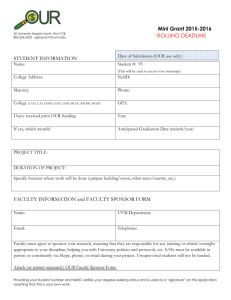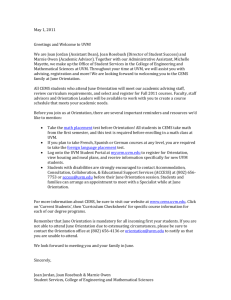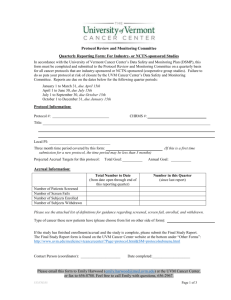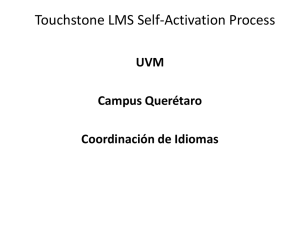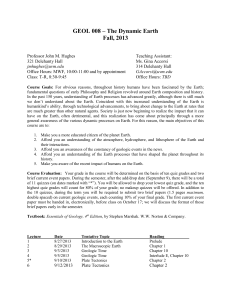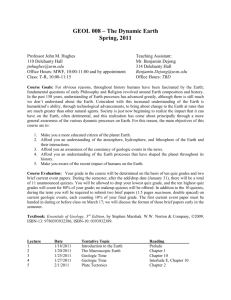GRNU 344: Optimizing Health Practicum
advertisement
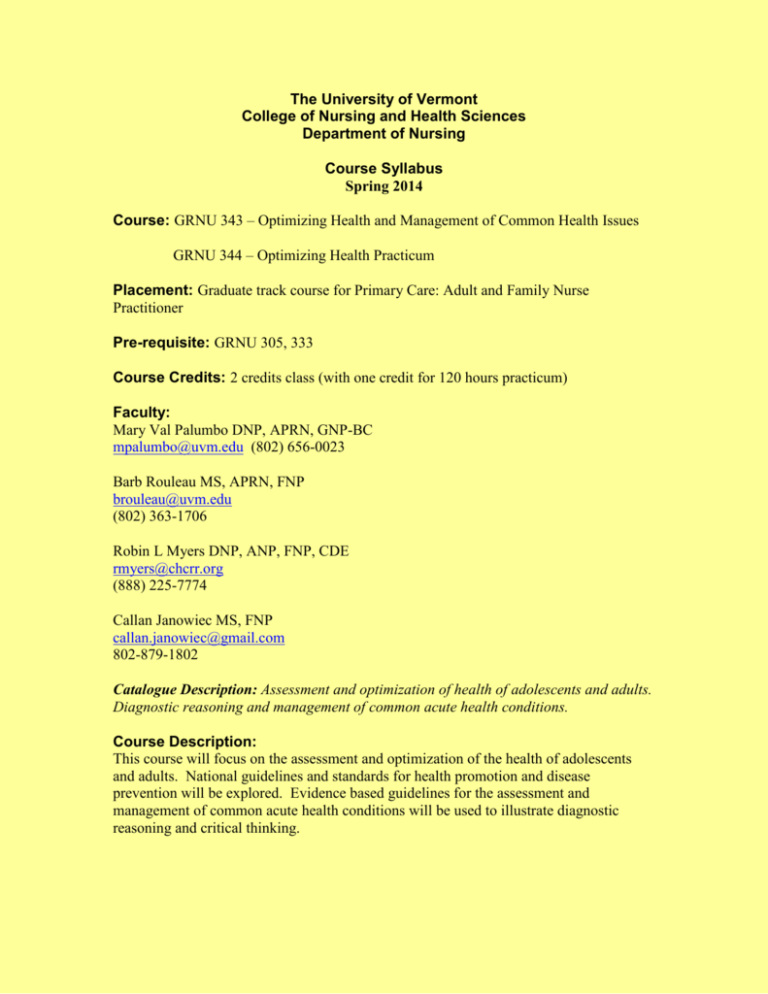
The University of Vermont College of Nursing and Health Sciences Department of Nursing Course Syllabus Spring 2014 Course: GRNU 343 – Optimizing Health and Management of Common Health Issues GRNU 344 – Optimizing Health Practicum Placement: Graduate track course for Primary Care: Adult and Family Nurse Practitioner Pre-requisite: GRNU 305, 333 Course Credits: 2 credits class (with one credit for 120 hours practicum) Faculty: Mary Val Palumbo DNP, APRN, GNP-BC mpalumbo@uvm.edu (802) 656-0023 Barb Rouleau MS, APRN, FNP brouleau@uvm.edu (802) 363-1706 Robin L Myers DNP, ANP, FNP, CDE rmyers@chcrr.org (888) 225-7774 Callan Janowiec MS, FNP callan.janowiec@gmail.com 802-879-1802 Catalogue Description: Assessment and optimization of health of adolescents and adults. Diagnostic reasoning and management of common acute health conditions. Course Description: This course will focus on the assessment and optimization of the health of adolescents and adults. National guidelines and standards for health promotion and disease prevention will be explored. Evidence based guidelines for the assessment and management of common acute health conditions will be used to illustrate diagnostic reasoning and critical thinking. Course Objectives: (GRNU 343) At completion of this course, the student will be able to: 1. Explain health screening recommendations for adolescents and adults. 2. Identify health risks and health promotion needs of adolescents and adults. 3. Explain client education for health promotion. 4. Describe selected behavior change strategies to enhance the health of adolescents and adults. 5. Critically analyze assessment data to formulate differential diagnosis for adolescents and adults. Course Objectives: (GRNU 344) At completion of this clinical practicum, the student will be able to: 6. Select appropriate therapeutic interventions and treatments for common acute health conditions. 7. Prescribe strategies for individuals and families to enhance health promoting behavior for the prevention of illness and injury, improvement of function and well-being, and maintenance of health. 8. Perform appropriate components of the history and physical exam for a brief or complete assessment of common health problems and overall health status. Course Topics: Domains/competencies of nurse practitioner practice Health promotion and disease prevention National guidelines for primary and secondary health prevention Behavior change strategies Assessment and management of common acute health conditions Teaching Strategies: * We will meet 7 times for lecture, sharing of clinical experiences, and discussion and debate of health promotion guidelines. * There will be 7 online classes to participate in. * You will each have at least one site visit from a faculty member. * We will utilize standardized patients for 2 sessions, practicing documentation on an Electronic Medical Record and for evaluation of clinical progression/ meeting of clinical objectives. * 120 hours will be spent with a clinical preceptor in a healthcare setting. Course Policies: All course assignments must be completed for a passing grade to be achieved. Students are expected to complete course assignments by the due dates identified in the syllabus. Unless previously approved, course assignments not completed by the due date will be penalized 2 points per day. All students must acquire a minimum of 120 hours of clinical experience during this course and satisfactorily complete the clinical objectives. Students who miss a “Standardized Patient (SP)” learning experience will be expected to attend a “Make-up Session.” This is an additional expense for the course and each student will be responsible for the increased cost of having the SP available (maximum cost/students is $40 – actual cost dependent upon number of students and number of hours SP is needed). Students must demonstrate competency in the theoretical aspects of the course as well as in the clinical application of the content through their practicum experiences to receive a passing grade. Students who do not receive a satisfactory grade for the practicum experience will receive a grade of "F" for the entire course. An unsatisfactory grade in a clinical course may be grounds for dismissal. Grading Policy: (Department of Nursing Graduate Completion Policy (effective 8/30/2013) Students are required to earn a final grade of B or better in the course. If a student earns two grades of B- or any grade below B- is grounds for dismissal. Students are required to earn a satisfactory grade in clinical. An unsatisfactory grade in a clinical course is grounds for dismissal. In order to graduate, all program requirements must be met within one academic semester of completion of final practicum. Refer to the Department of Nursing Graduate Handbook and The University of Vermont Graduate Catalogue for additional information regarding grading. Course Assignments/Evaluation Methods: Attainment of course objectives will be evaluated on: Assignment % of Grade Office note from standardized patient visit (submitted on the 5% PRISM EMR) Due Date 2/17/14 Cancer Screening: Oral Debate 10% 2/27/14 Or 3/20/14 Risk Appraisal: young, middle-aged,(5%) and older adult (5%) 10% 3/20/14 And 4/3/14 Health promotion activities and reflective blog 35% By 4/30/14 Midterm 10% 2/24 and 2/25 Class and online participation 5% ongoing Office note from standardized patient visit (submitted on the 5% PRISM EMR) 5/09/14 Final Exam 20% 4/24/14 Clinical Log S/U 5/10/14 Student self evaluation of clinical proficiency S/U 5/11/14 Student evaluations of preceptor/clinical site S/U 5/11/14 Faculty evaluation (site visit or standardized patient) of student clinical proficiency S/U 5/11/13 Preceptor evaluation of student clinical proficiency S/U 5/11/13 Test out with standardized patient S/U 5/11/13 Required Texts: The Guide to Clinical Preventive Services 2012 128 pp. PDF or Pocket-sized guide is a compilation of abridged USPSTF recommendations released from 2002 to March 2010 that can be used as an evidence-based tool at the point of patient care. (AHRQ 10-05145; single copy costs is $5).Go to http://www.ahrq.gov/clinic/pocketgd.htm and order this as soon as possible. Miller, WR and Rollnick, S, (2012) Motivational Interviewing Helping People Change. New York, NY: Guilford Press. Bickley, Lynn. (2007). Bates' Guide to Physical Examination and History Taking, (9th Edition). Lippincott ISBN: 0781767180 Henderson, MC, Tierney, LM, and Smetana, GW. The Patient History An EvidencedBased Approach to Differential Diagnosis. (2012) McGraw Hill Medical Subscription to a “point of care” clinician’s network is required and should be downloaded onto a handheld devise. Here are three options: UpToDate - http://www.uptodate.com/home/clinicians/index.html - UpToDate, which is available through the Web and Mobile Devices, combines the best evidence with the experience of expert physicians around the world. Whenever you have a clinical question, you can tap into the collective wisdom and experience of our faculty of over 4,400 leading clinicians. Recommended Books: (You may use any other book as your preferred “go to” reference for diet, physical exercise, and cancer information. Choose a book that you plan to read in its entirety and use for clinical teaching). Here are my choices: Ades, Philip and Editors of Eating Well, (2008) Eating Well for a Healthy Heart Cookbook: a cardiologist’s guide to adding years to your life. New York, N.Y.: Countryman Press. (It’s available at the FAHC gift shop in the ACC) Marcus, B. H. & Forsyth, L. H. (2008). Motivating people to be physically active. Champaign, IL: Human Kinetics. Recommended Websites: National Cancer Institute. Cancer screening overview (PDQ) Retrieved from http://www.cancer.gov/cancertopics/pdq/screening/overview/HealthProfessional. USDA, My Plate for Professionals. Retreived from http://www.choosemyplate.gov/information-healthcare-professionals.html Explanation of course assignments Office notes - The focus of your assessment should be the primary diagnosis (as appropriate) and health risk appraisal with the focus of your intervention on addressing the identified needs of health care maintenance, risk appraisal, asymptomatic screening, health promotion, and disease prevention. Cancer Screening: Oral Debate – Succinctly written synopsis for posting online. We will have a debate about the recommendations to screen for skin, colon, breast, lung, prostate, and cervical cancer. Prepare to defend your position – explain the evidence or lack of evidence, explain the benefit or the downside, explain how you will present this to your patients….the goal is to recognize the “problems” with screening yet the “benefits” of screening, to understand the statistics of cancer, to recognize the limitations of published research, and to develop a strategy/approach to recommendations for cancer screening that you may adopt in your practice. Dr, Welch’s book Should I Be Tested for Cancer? or Over-diagnosed: Making People Sick in the Pursuit of Health H. Gilbert Welch Lisa Schwartz , Steve Woloshin will be very helpful for this assignment. Grading based upon the use of evidence to defend your position, clear articulation of the reasons for your position, and a succinct description of how you will present this view to patients using clear communication. Risk Appraisal: young, middle-aged, and older adult – You will be given a brief description of a patient. For each patient, post a written response to the following questions. This will be a succinctly written “group” synopsis for posting online. Include the references you used to support your recommendations. 1. What are the leading causes of death for this age group? 2. What risk appraisal and what screening (questions, diagnostic tests) are a high priority for this patient? 3. What specific health promoting behaviors are important for this patient? 4. Are there any immunizations you would recommend for this patient? 5. Is there any chemoprophylaxis you would recommend for this patient? Service Learning – Employer health promotion activities and reflective blog This activity will provide each graduate student with and opportunity to practice “brief” health promotion encounters at a worksite. This time spent explaining a healthy behavior may be comparable to health promotion opportunities in a busy primary care setting. The student will develop skills and tools for use in clinical practice as a nurse practitioner. See posted instructions. Other information: Student Learning Accommodations: In keeping with University policy, any student with a documented disability interested in utilizing accommodations should contact ACCESS, the office of Disability Services on campus. ACCESS works with students to create reasonable and appropriate accommodations via an accommodation letter to their professors as early as possible each semester. Contact ACCESS: A170 Living/Learning Center; 802-656-7753; access@uvm.edu; www.uvm.edu/access UVM’s policy on disability certification and student support: www.uvm.edu/~uvmppg/ppg/student/disability.pdf Religious Holidays: Students have the right to practice the religion of their choice. If you need to miss class to observe a religious holiday, please submit the dates of your absence to me in writing by the end of the second full week of classes. You will be permitted to make up work within a mutually agreed-upon time. Academic Integrity: The policy addresses plagiarism, fabrication, collusion, and cheating. www.uvm.edu/~uvmppg/ppg/student/acadintegrity.pdf Grade Appeals: If you would like to contest a grade, please follow the procedures outlined in this policy: www.uvm.edu/~uvmppg/ppg/student/gradeappeals.pdf Grading: For information on grading and GPA calculation, go to www.uvm.edu/academics/catalogue and click on Policies for an A-Z listing. Code of Student Rights and Responsibilities: www.uvm.edu/~uvmppg/ppg/student/studentcode.pdf FERPA Rights Disclosure: The purpose of this policy is to communicate the rights of students regarding access to, and privacy of their student educational records as provided for in the Family Educational Rights and Privacy Act (FERPA) of 1974. http://www.uvm.edu/~uvmppg/ppg/student/ferpa.pdf

